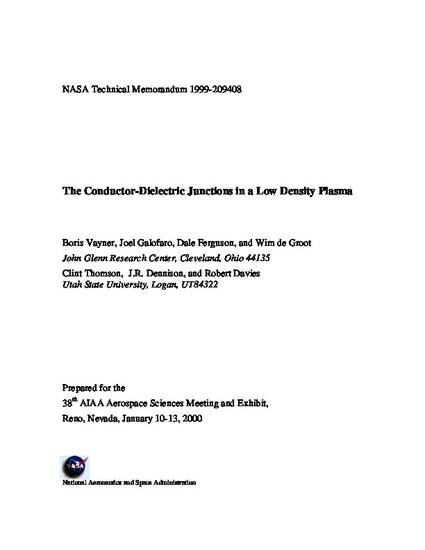
A conductor-dielectric junction exposed to the space environment is a frequent spacecraft design feature. Due to spacecraft charging and/or solar array operation, the conductor can acquire a high potential with respect to the surrounding plasma. If this potential is positive the insulators adjacent to exposed conductors can collect current as if they were conductors themselves. This phenomenon, called snapover, results in a substantial increase in current collection, and may even result in a glow discharge if the potential is high enough. If a conductor has a negative potential, arcing can occur at the site of a junction. Both of these phenomena negatively affect spacecraft operation. To prevent negative consequences, the physical mechanisms of snapover and arc inception require investigation. In this paper, results are presented of an experimental and theoretical study of snapover, glow discharge, and arc phenomena for different materials immersed in argon or xenon plasmas. The effect of snapover is investigated for several metal-dielectric junctions: copper-teflon, copper-Kapton, copper-glass, aluminum-teflon, aluminum-Kapton, steelteflon, anodized aluminum with pinholes, and copper-ceramics. I-V curves are measured and snapover inception voltages, essential parameters (increase in current and collection area due to secondary electrons), and glow discharge inception thresholds are determined. Optical spectra are obtained for glow discharges in both argon and xenon plasmas. These spectra provide information regarding atomic species entrapped in the glow region. Some spectral lines can be used to estimate plasma parameters in the discharge area. A videocamera and linear array were used to confirm that snapover inception is accompanied by very low intensity visible light emission. This result seems to be important for the estimate of the light pollution around spacecraft. Optical spectra (wavelengths 380-650 nm) of arcs are also obtained on a negatively biased chromic acid anodized aluminum plate immersed in low density argon and xenon plasmas. Analysis of these spectra confirms our earlier findings that aluminum atoms are ejected from the arc site. Moreover, it is found that chromium atoms are also quite abundant in the arc plasma. It is believed that the latter results contribute considerably to the understanding of processes of plasma contamination caused by arcing.

Paper presented at the 38th AIAA Aerospace Sciences Meeting and Exhibit. PDF available for download through link above.